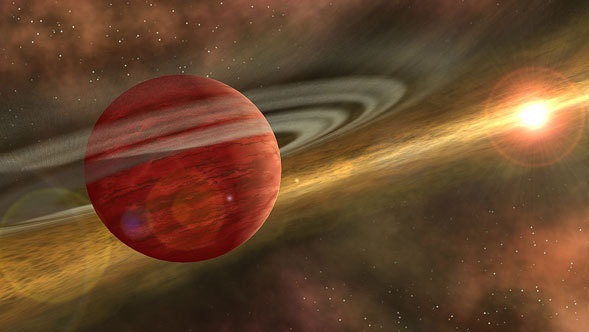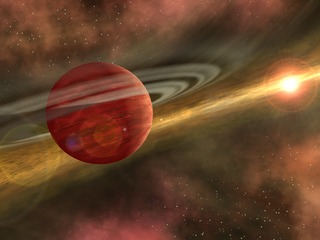
News Release • September 12th, 2007 • feature07-14 •
Written by Linda Vu
Spitzer Science Center
On Earth, neon signs point to motel vacancies and nearby eateries. Now for the first time, astronomers have spotted neon gas in disks around stars -- and they're hoping the glowing gas will point the way to new discoveries about how planets rise from the materials that swirl around young stars.
"Gas is a very important ingredient in the evolution of a circumstellar disk. It plays an important role in the temperature balance and density structure of the disk, the chemistry, the dynamics, and eventually the formation of gas-rich and gas-poor planets," says Dr. Fred Lahuis of Leiden Observatory and SRON -- the Netherlands Institute for Space Research.
"Finding the signature of ionized neon in the spectra of about twenty star systems of different ages is quite exciting for us," he adds.
According to Lahuis, the detection of ionized neon is particularly useful because it allows astronomers to track the gas content around young stars during the different stages of their development.
Very few chemical elements in the universe are found in their pure form. In the disks surrounding a young star, most elements either bond to form molecules, like water, or condense to a solid state, forming dust grains or ice. These reactions complicate the chemical "picture" of planet formation around star. However, neon makes things simple. As one of chemistry's "noble elements," neon does not easily make chemical bonds or form larger molecules. Lahuis notes that studying this gas in its pure form may lead to a better understanding of how planets form.
Tracking Planet Formation
Astronomers believe that planets form like snowballs over millions of years, as small dust grains clump together to form larger bodies. Some of these cosmic rocks then smash together to form rocky planets, like Earth, or the cores of gas giant planets like Jupiter. The more massive the planetary core is, the more gravity it wields. If the core is massive enough, it may pull in gas from the surrounding disk to form an atmosphere. "Neon is special because we can detect very small amounts of it and it is likely coming from the planet-forming region of protoplanetary disks," says Catherine Espaillat, a graduate student at the University of Michigan, Ann Arbor, Mich. "This helps put constraints on gas giant planet formation,"
Like a sign illuminated in deep space, astronomers can spot neon with Spitzer's infrared spectrometer. Once a neon atom absorbs X-ray and extreme ultraviolet light from its central star, it will then give off lower-energy infrared light, which Spitzer sees.
According to Dr. Ilaria Pascucci of the Steward Observatory at the University of Arizona, Tucson, neon's relationship with this high-energy light may also provide valuable insights into how the disk around a young star goes from gas-rich, with no planets, to gas-poor, with planets. She notes that only a fraction of the gas that starts out in the disk actually ends up in the atmosphere of planet.
"Most of the primordial gas in the disk ends up in the star, it is accreted [or falls] onto the star. After accretion onto the star is reduced, we think that most of the remaining gas evaporates into space in a process called photoevaporation," says Pascucci.
As extreme ultraviolet and X-ray light heat the gas in the disk, the gas molecules become increasingly energetic. With enough energy, gravity from the star and the disk will no longer be strong enough to hold on to the heated gas -- allowing it to float off into space, or photoevaporate. Scientists suspect that if too much gas evaporates too quickly, gas giant planets may not be able to form.
According to Pascucci, gas around a young star may also play a crucial role in making planets suitable for life. The gas may help to circularize the orbits of planets as they form, as well as create atmospheres for rocky Earthlike and gas giant planets alike. Both the orbit of a planet and its atmosphere play an important role in stabilizing its climate, and perhaps in determining whether or not complex life can form and survive.
The detection of ionized neon was discovered in data obtained from two Spitzer Legacy Program teams: From Molecular Cores to Planet Forming Disks (c2d) and The Formation and Evolution of Planetary Systems (FEPS); and one Guaranteed Time Observing program called Spitzer IRS_Disks.
Pascucci and the FEPS team first presented the detection of Neon II emission towards four circumstellar disks at the 2006 conference "The Planet-Disc Connection." Their paper on the topic was published in the July 2007 edition of Astrophysical Journal.
The detection of Neon II toward 15 sources from the c2d sample is part of Lahuis' PhD thesis study. Meanwhile, the detection of Neon II around disks where planets have already formed in the Spitzer IRS_Disks study was the focus of Espaillat's PhD thesis.
Also, hear the podcast!





